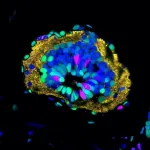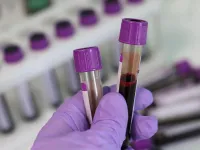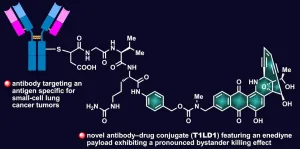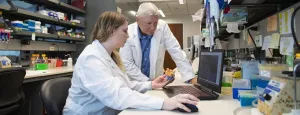(Press-News.org) Coastal wetlands like seagrass meadows, mangroves, and salt marshes play vital roles along the shoreline, from providing a buffer against storm surges, to providing critical habitat for animals, to capturing atmospheric carbon.
We are still just beginning to comprehend the intricate workings of these highly productive ecosystems and their role in mitigating the climate crisis, but UConn researchers are one step closer to understanding how salt marsh vegetation, their bacterial communities, and vegetation can help predict a marsh's potential to be a blue carbon reservoir. The research was recently published in the journal Estuaries and Coasts.
"Coastal marshes are increasingly recognized as important ecosystems because they sequester and store a lot of carbon. There is increasing interest in understanding these blue carbon ecosystems because of our current climate crisis," says Beth Lawrence, co-author and College of Agriculture, Health, and Natural Resources Assistant Professor of Wetland and Plant Ecology in the Department of Natural Resources and the Environment and Center for Environmental Science and Engineering.
Lawrence explains how salt marshes serve as focal ecosystems in conservation and restoration. They are habitat for a wide range of species, including endangered species like the salt marsh sparrow. Located at the interface between land and sea, these ecosystems buffer storm energy and perform other important functions, like the removal of excess nitrogen from water making its way to estuaries where it may otherwise lead to algal blooms and oxygen-deprived "dead zones."
Development leads to changes in the movement of water (see side bar) and Lawrence says that, often, tide-restricted salt marshes become less salty and wet, leading to shifts in what plants grow there. Plants that thrive in these brackish conditions can be invasive, like Phragmites australis, which has become the bane of coastal managers, Lawrence says.
Tidal restoration aims to reconnect marshes cut off from the ocean to improve habitat. Increasing the size of culverts underneath roads, railroads or bridges or removing tide gates can restore tidal flow and the organisms that rely on it.
To observe how tidal restoration may alter carbon cycling and soil microbes, the researchers sampled from several marsh locations in Connecticut, including less-disturbed "reference" marshes, and formerly restricted marshes that have since undergone restoration.
"Tidally restored and the unrestored references differed in carbon density and how much carbon is in the soil. Highly restricted sites presumably had dried out to some degree and lost some carbon," says Lawrence.
This makes sense, Lawrence says, because in wetter soils, microbes do not break down carbon-rich plant material as efficiently as in dry soil, therefore the material and the carbon within it remains. When microbes can feast away on the plant matter in drier, more oxygenated conditions, the carbon is lost to the atmosphere in the form of carbon gas, in a process called mineralization.
Other measurements between tidally restored and undisturbed marshes were the same across the suite of parameters used in the researchers' measurements, including soil chemistry, plant biomass, and microbial communities. However, there were large differences across vegetation zones.
"The key difference we saw were across plant communities," Lawrence says. "We saw differences in microbial respiration as well as the microbial communities living in the soils in different vegetation zones. These findings suggest that both plants and microbes are responding to differences in environmental conditions."
With the knowledge of which plants thrive where, the researchers can get a glimpse into the biological processes at play within the marsh by noting which plants are present.
"I think one of the key takeaways from our study is that these bands of vegetation are good indicators of what's going on hydrologically and biogeochemically," says Lawrence. "For example, if we see native Spartina alterniflora growing, we know the environment is saltier than where Phragmites is growing. These soils are likely to have different bacterial community composition and process carbon and nitrogen differently than in a higher, drier community."
Considering the importance of salt marshes and the need for further restoration work, Lawrence says managers could use satellite imagery or drones to look at the vegetation at greater spatial scales to get an indication of growing conditions as well as a system's carbon capture capacity. This could help in focusing restoration efforts and monitoring.
"Managers are really interested in scaling up," Lawrence says. "Quantifying carbon and nutrient cycling is very time-consuming and detailed so an important implication of this work is that the dominant vegetation in salt marshes can be used as a proxy for some biogeochemical processes. We have to carefully consider how we're spending our limited conservation dollars."
INFORMATION:
Most of us have genetic variations that increase the risk of medicinal products not being effective. In order to provide a more effective treatment with fewer side effects, we need to analyse more of these genetic variations. This will provide us with more precise knowledge about how the individual patient reacts to medicinal products. A new research result from Aarhus University shows that.
Personalised medicine has been a hot topic in recent years, using information about the genes to adapt the treatment to the individual patient. Personalised medicine potentially provides better treatment and fewer side effects for the patient. At least in ...
WASHINGTON, June 22, 2021 -- About 2.2 billion people globally lack reliable access to clean drinking water, according to the United Nations, and the growing impacts of climate change are likely to worsen this reality.
Solar steam generation (SSG) has emerged as a promising renewable energy technology for water harvesting, desalination, and purification that could benefit people who need it most in remote communities, disaster-relief areas, and developing nations. In Applied Physics Letters, by AIP Publishing, Virginia Tech researchers developed a synthetic tree to enhance SSG.
SSG turns solar energy into heat. Water from a storage ...
A team of scientists from the Leibniz Institute for Food Systems Biology at the Technical University of Munich has now discovered that the odorant receptor OR5K1 is specialized to recognize pyrazines in both humans and domesticated animals. These are volatile substances that contribute to the typical odor of many vegetables or are formed when food is heated. In addition, pyrazines also play a role as signaling substances in intra- or interspecific communication. The new research results contribute to a better understanding of the molecular mechanisms underlying the odor perception ...
A single measurement result is not a proof - this has been shown again and again in science. We can only really rely on a research result when it has been measured several times, preferably by different research teams, in slightly different ways. In this way, errors can usually be detected sooner or later.
However, a new study by Prof. Andrej Pustogow from the Institute of Solid State Physics at TU Wien together with other international research teams shows that this can sometimes take quite a long time. The investigation of strontium ruthenate, a material that plays an important role in unconventional superconductivity, has now disproved an experiment that gained fame in the 1990s: it was believed that a novel form of superconductivity ...
The spinal cord is an important component of our central nervous system: it connects the brain with the rest of the body and plays a crucial part in coordinating our sensations with our actions. Falls, violence, disease - various forms of trauma can cause irreversible damage to the spinal cord, leading to paralysis, sometimes even death.
Although many vertebrates, including humans, are unable to recover from a spinal cord injury, some animals stand out. For instance, the axolotl (Ambystoma mexicanum), a salamander from Mexico, has the remarkable ability to regenerate its spinal cord after an injury. When an axolotl's tail is amputated, neural stem cells residing in the spinal cord are recruited to the injury ...
Researchers have identified a combination of biological markers in patients with dengue that could predict whether they go on to develop moderate to severe disease, according to a study published today in eLife.
Biomarkers are used to identify the state or risk of a disease in patients. Examples of biomarkers can include naturally occurring molecules or genes in the vascular, inflammatory or other biological pathways. The new findings could aid the development of biomarker panels for clinical use and help improve triage and risk prediction in patients with dengue.
Dengue is the most common mosquito-borne viral disease to affect humans globally. In 2019, the World Health Organization identified dengue as one of the top 10 threats to global health, with transmission occurring ...
The ancient Maya city of Tikal was a bustling metropolis and home to tens of thousands of people.
The city comprised roads, paved plazas, towering pyramids, temples and palaces and thousands of homes for its residents, all supported by agriculture.
Now researchers at the University of Cincinnati say Tikal's reservoirs -- critical sources of city drinking water -- were lined with trees and wild vegetation that would have provided scenic natural beauty in the heart of the busy city.
UC researchers developed a novel system to analyze ancient plant DNA in the sediment of Tikal's temple and palace reservoirs to identify more than 30 species ...
HOUSTON - (June 22, 2021) - How do you kill tumor cells that can't be targeted? Get their more susceptible neighbors to help.
The Rice University lab of synthetic chemist K.C. Nicolaou, in collaboration with AbbVie Inc., has created unique antibody-drug conjugates (ADCs) that link a synthetic uncialamycin analogue to antibodies that target cancer cells.
Once they enter the targeted tumor cells, these ADCs exhibit a "significant bystander effect," according to the study. In other words, cancerous neighbor cells that aren't directly attacked by the drugs are also affected.
The study in the Proceedings of the National Academy of Sciences presents "an intriguing opportunity ...
Researchers at the University of Cincinnati College of Medicine have developed a blueprint for a protein that plays an important role in the development and regulation of reproductive organs.
The knowledge advances our understanding of the protein anti-Müllerian hormone hormone (AMH), which helps form male reproductive organs and in females regulates follicle development and ovulation in the ovaries, explains Thomas Thompson, PhD, professor in the UC Department of Molecular Genetics, Biochemistry and Microbiology.
Scientists have been looking to regulate AMH because it might play a role in developing a novel contraceptive, aid in treatments for infertility ...
An enzyme found in fat tissue in the centre of our bones helps control the production of new bone and fat cells, shows a study in mice published today in eLife.
The findings may help scientists better understand how the body maintains fat stores and bone production in response to changing conditions, such as during aging. They may also suggest new approaches to treating conditions that cause bone loss in older adults.
Fat cells, including those found in the bone marrow, are increasingly recognised as an important part of the body that helps regulate body weight, insulin sensitivity and bone mass. Fat tissue ...







